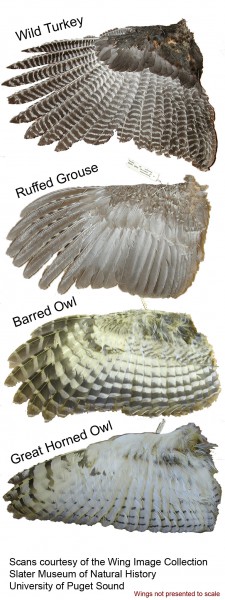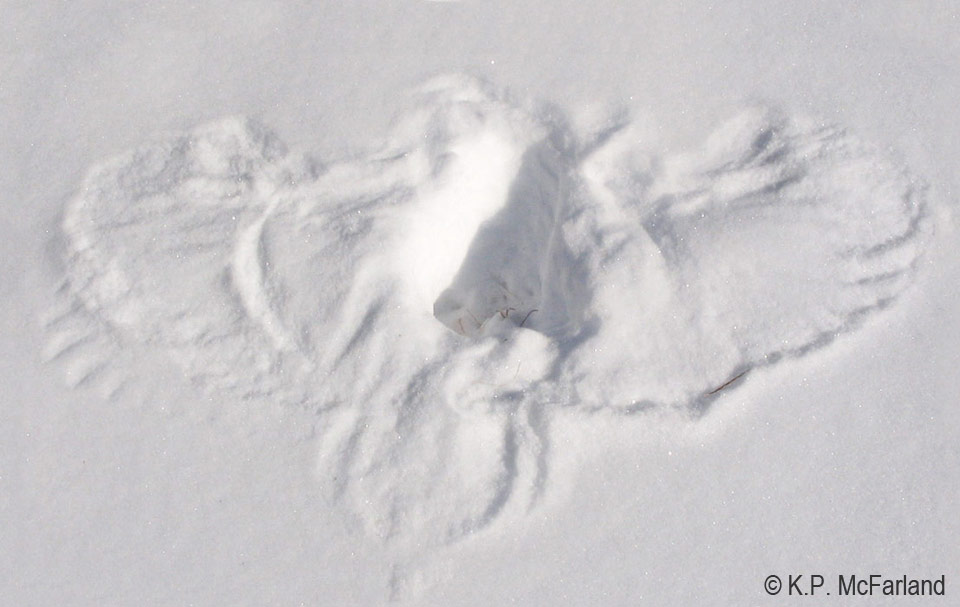Wing Prints
By Bryan Pfeiffer* and Kent McFarland
 With all the early snow in the U.S. this winter, birds have been making impressions – literally. We’re seeing various wing prints in the snow. It makes us wonder about the reliability of identifying prints made here in Vermont – most likely by Barred Owl, Great Horned Owl, Ruffed Grouse or Wild Turkey. Can we get them right? Well … not always.
With all the early snow in the U.S. this winter, birds have been making impressions – literally. We’re seeing various wing prints in the snow. It makes us wonder about the reliability of identifying prints made here in Vermont – most likely by Barred Owl, Great Horned Owl, Ruffed Grouse or Wild Turkey. Can we get them right? Well … not always.
Your first step should be to look beyond the wing print. The footprints of Wild Turkey or Ruffed Grouse are distinctive. Grouse scat can offer another clue. We’ve seen grouse scat in various wing prints that might otherwise look a lot like it came from an owl.
But what about prints alone – without any other clues? Bryan assembled wing scans (from the Slater Museum of Natural History at the University of Puget Sound) for a general guide to wing shapes (these are not presented to scale).
Even so, we’ve concluded that a bird taking off or landing can vary the wing position far too much for the presentation of consistent patterns. Rarely do we find a perfect impression. We can sometimes recognize pointed outer primaries on a Wild Turkey. So perhaps you might use the turkey footprints to clue you in to this print and learn the pattern.
Beyond that, identification with certainty is fraught. We can’t use feather counts; and wingspan has its problems. Published wingspan measurements assume the wings are completely spread out on the horizontal. And, even if they are spread fully in the wild, Barred and Great Horned owls overlap in size.
Even then, how would we determine that the print was made on a perfect horizontal? Most of what we see in the field can be 20 to 30 degrees off horizontal. To adjust, we’d have to employ trigonometry.
So, unless we find foot prints or scat, we’ve decided to dispense with the math – and simply enjoy these avian snow angels.
* By the way, this is a revised version of a post that appeared on my old blog, The Daily Wing, which is now also appearing on the blog of the Vermont Center for Ecostudies. And full disclosure: I’m currently on “temporary assignment” in the desert of New Mexico, where we had a dusting of snow down to about 5,500 feet two nights ago. Life is so unfair.



Thanks, Rollin! I’ll post your photo soon. I think I’ll start collecting these here. Stay tuned!
Bryan,
An outstanding blog!…especially this time of year. I found a cool print several years ago…I have no idea what made it..I will send the photo to your website.
Rollin
Hi Sue, It’s great to hear from you. I think I might invite folks to send me KNOWN wing prints. Maybe we can sort through the “known knowns” and the “known unknows.” Sorry. 🙂 Oh, and by the way, here’s the lep list so far from New Mexico (not a ton flying):
Papilio polyxenes
Colias philodice
Colias eurytheme
Nathalis iole
Eurema nicippe
Eurema mexicana
Hemiargus ceranus (I think)
Euptoieta claudia
Vanessa virginiensis
Vanessa cardui
Pyrgus communis/albescens
Again, you got my attention. Great info. I never counted on ID from wing prints alone, but you made me wonder with the wings in your blog. The last snow here in New Salem was great for tracking. No angel wings though. Had red fox moving and scenting stumps and seedling hemlock… and fisher, coyote, red and gray squirrel, mice and shrews. So, there are a few interesting mammals that we share our woodland trails. It is nice to know that they still live and hunt here in spite of our use of their territories.
Glad to hear you are in New Mexico- envy is the operative word. Please post photos…